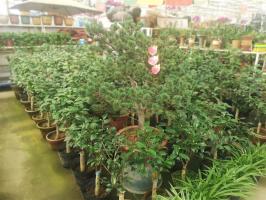What to Use for Potted Plant Water Management
Keeping potted plants happy and healthy requires proper watering, something that often proves challenging for even experienced gardeners. Fortunately, there are several tools and techniques available to help you manage your potted plant watering schedule and ensure they receive the proper amount of moisture.
Use a Self-Watering Container
Self-watering containers are a great option for those who struggle with maintaining a consistent watering schedule. These containers typically consist of two parts: an outer pot and an inner pot or reservoir. The inner pot holds the plant and soil, while the outer pot houses the water. As the plant uses the water in the soil, the reservoir replenishes it automatically, ensuring your plant receives the right amount of moisture.
Invest in a Soil Moisture Meter
A soil moisture meter is an inexpensive and useful tool for monitoring your plant's water needs. These small devices are inserted into the soil, giving an accurate reading of the soil's moisture level. This allows you to determine when your plant needs watering, preventing both over and under-watering. Soil moisture meters are particularly useful for plants that require regular watering and those in pots without drainage holes.
Implement a Watering Schedule
Creating a consistent watering schedule can be an effective way to manage your potted plants' water needs. The frequency and amount of watering will depend on the type of plant, the size of the pot and the environment in which it is growing. As such, it is important to research your plant species to determine its watering requirements. You may also consider recording your watering schedule in a planner or using a reminder app to help you stay on track.
Invest in a Drip Irrigation System
A drip irrigation system is a more advanced watering method that can save time and water when managing potted plants. These systems consist of tubing that delivers water directly to the plant's soil, gradually and consistently watering the plant over time. Drip irrigation systems can be DIY or purchased as pre-assembled kits, making them a great option for busy gardeners or those growing several potted plants.
Proper Drainage is Key
No matter which watering method you choose, proper drainage is essential for keeping plants healthy. Without proper drainage, plants can become waterlogged, leading to root rot and other fungal diseases. Make sure your pots have adequate drainage holes and consider using a layer of gravel or stones at the bottom of the pot to ensure water can flow freely through the soil.
Conclusion
Managing potted plant water requirements may seem challenging at first, but with the right tools and techniques, it can be a rewarding experience. By investing in a self-watering container, soil moisture meter, drip irrigation system or simply implementing a watering schedule, your plants will thrive and add beauty to your living space. Remember, no matter which method you choose, proper drainage is key to keeping your plants healthy, so don't forget to ensure your pots have adequate drainage holes.

 how many times do yo...
how many times do yo... how many planted tre...
how many planted tre... how many pine trees ...
how many pine trees ... how many pecan trees...
how many pecan trees... how many plants comp...
how many plants comp... how many plants can ...
how many plants can ... how many plants and ...
how many plants and ... how many pepper plan...
how many pepper plan...
































